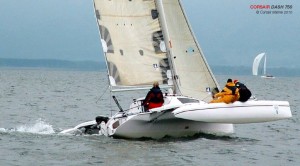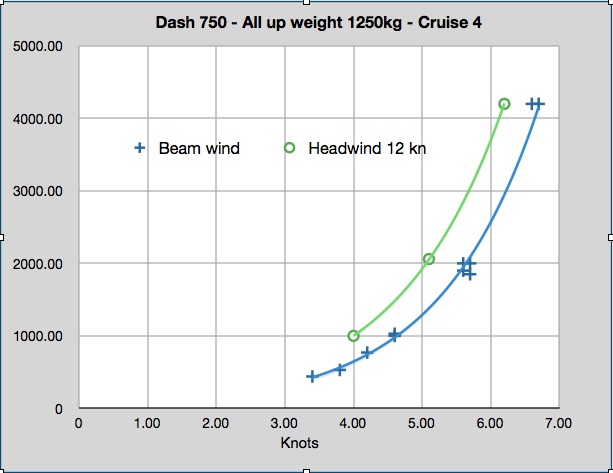The Blue book is the yacht racing rule book and it stipulates windward performance under power. And the requirement is that the boat can make the nominated speed into 12 knots of headwind.
Waterline length (Lw) is the basis of the calculation and for the Dash 750 it is 7.32 and so that works out at 1.8 x √7.32 = 4.8 knots. This afternoon the we have a nice breeze of 10-12 knots so its just what we need for this test.
Todays trial is with Dave Renouf who is a dealer for Corsair trimarans based at Birkenhead Pt Marina in Sydney – click here for more info.
For the test we used a Cruise 4 and 4x Optima 55 ah blue top batteries. The all up weight of the boat, batteries, Cruise 4, the petrol outboard and Dave and I is 1250kg. We tested on Pittwater just out from Crystal Bay and did two runs for each speed at right angles to the wind. And we also did the conformance test with her heading straight into the wind.
We used the Cruise 4 because that allows us to simulate the Travel 1003, and the Cruise 2 as well, by simply running at a lower throttle setting.
You can see on the graph the green line is the conformance trial and you’ll see first two data points are at 1000, 2000 watts, representing the Travel 1003, and the Cruise 2. Our target speed is 4.8 knots and you can see that the Travel 1003 would not be powerful enough on this boat—it does about 4 knots at this power. The Cruise 2 would be sufficiently powerful to push the Dash 750 at the required speed, and with a little in reserve.
When using the Cruise 2, only two of these batteries would have been required, and so the weight would be reduced by about 36 kg. (The Cruise 2 weighs more or less the same as the Cruise 4)
Even though its 13kg total weight makes it especially appealing for a racing boat, its upwind performance is not quite enough to meet the racing rules rules.
So this boat would need to be fitted the Cruise 2 with a couple of deep cycle batteries mounted down below. For weight conscious racers, Lithium batteries are interesting alternative. They also have the advantage of not suffering voltage sag under the high current loads that you see with electric outboards.
They also offer advantages for boats that are sola powered because they are virtually no losses in charge and discharge, so all the energy harvested from solar panels can be used for driving the motor.





The Travel 1003 does not use the same prop as the Cruise motors so the performance would not be comparable at similar RPM’s. You would have to use the 801 since it has the same prop as the Cruise motors.
Hi Steve,
Hi Steve, Thanks for dropping by and contributing to the discussion. That’s indeed true that the props are different. And you are correct that the performance would not be comparable at similar RPMs. But what we are comparing is power, not RPMs.
We are looking for a reasonable approximation so we could get a good idea of what the performance of the 1003 might be, and whether it could be powerful enough to meet the racing rules requirement. I’m confident the test will be close enough for that.
Consider the tests we’ve done in the past with different props on the same vessel: From the tests of the 1003 using the two different props on the inflatable kayak – the three bladed prop and the standard two bladed prop we can see that there is a slight difference in performance, but a very similar shaped curve. And from the even earlier tests of my comparison between the speed prop and the standard prop with the Cruise 4 on Current Sunshine, there was no discernable difference in power at the same speed. Even though at a given point on the curve, the two props are running at different revs.
What is different between the different props is maximum speed, especially when the power consumption of the lower pitched prop is less than the maximum of the motor in question. Say we were testing the 1003 on this boat, we might want to test with both props to be able to see the maximum speed, especially if the power when running the standard 1003 prop was less than 100 watts. Because we were running the Cruise 4 on this test, our power/speed curve goes way past the limits of the 1003 motor, and covers the potential range of both props.
If the test showed that we were close to required speed at 1000 watts it would be worth repeating with an actual 1003, but because it was not within reach, its clear that we’d need to use a Cruise 2 for these requirements.
PS. I’ve just added links to my previous comment so you can go to those entries and look at the graphs. Looking at the difference between the two props on the sea-eagle kayak its about 2 or 3 %. Thats quite a fine line and probably of a similar order of magnitude as the accuracy of the plots anyway.
Did you notice that in the test on Current Sunshine, it is the “slow prop” that is fastest? You could think of it as the speed prop is too high a gear for it and causes the motor to lug, and so can’t spin freely enough to get up to full RPMs.
On the other hand the kayak test it is the opposite. The standard prop is too low a gear for it, and even at full speed it odes not use the power that is available in the motor.
cheers,
-chris
If the 1003 were a miniature version of the Cruise models with the 3-blade prop and a cable adapter for an external battery bank I’d be tempted to buy one. I’ll stick with the 801 until Torqeedo sees the light. Thanks. Steve S.
Hi Steve, I agree with you. I even wrote a report on this which I sent to Torqeedo hoping that it would encourage them to release a battery adaptor sooner. Because the 1003 has so many other improvements over the 801, I think it would be really popular with a battery adaptor.
The kind of things I mean are such as its waterproofness that means its more suitable for use on a small yacht where it might be mounted on the transom where it could get dunked often. And that it can be used with the remote throttle which also makes it more appealing for use on a small yacht. Even on the inflatable kayak which I’ve written about the remote throttle is more suitable than a tiller that you have to reach behind you to use. For many uses its range is a limiting factor and a battery adaptor would make all the difference.
But you can already choose a 3 bladed prop to use on the 1003. Notice that the 503 comes standard with the three bladed prop. But its worth doing some tests on your boat first to make sure you know for sure which prop will be better. If its an easily driven hull it could be better to use the three-bladed prop. Check out my blog entry for prop tests on SeaEagle kayak.
Cheers
Chris
Re the battery adapter cables for the 1003. I would like to see the wire size increase from #10 to #8 on the cable. It’s #10 on the 801 cable adapter but that’s too small if you are approaching one KW inputs. Thanks. Steve S.